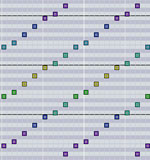Shepard tones
Shepard tones are special harmonically complex tones. They are named after the psychologist Roger Shepard (Shepard, 1964). With the help of the Shepard tones a number of acoustic illusions can be created ( tritone paradox , Shepard scale ).
Composition of the Shepard tones
Each Shepard tone is composed of a certain number of sine tones (usually 6 to 10). The frequencies of these sine tones are octave apart. The frequencies of a certain Shepard tone, which is composed of n many sine tones, are mathematically formulated as follows:
,
with and the basic frequency . The fundamental frequencies of Shepard tones mostly correspond to the fundamental frequencies of the tone classes of the chromatic scale (e.g. for the Shepard tone with the tone class C the fundamental frequency would be ). The volume of the frequencies is determined by means of a bell-shaped envelope curve . It is characteristic of this that the volume is attenuated in the low and high frequency ranges.
literature
- Roger N. Shepard: Circularity in judgments of relative pitch. In: Journal of the Acoustical Society of America. Vol. 36, No. 12, 1964, ISSN 0001-4966 , pp. 2346-2353, doi : 10.1121 / 1.1919362 .
- Diana Deutsch : The tritone paradox: Effects of spectral variables. In: Perception & Psychophysics. Vol. 41, No. 6, 1987, ISSN 0031-5117 , pp. 563-575, doi : 10.3758 / BF03210490 .
Web links
- Diana Deutsch , Psychology Dept 0109, University of California.
- Henning Koch: Visualization of the Shepard Effect . netalive.org . 2003-10.
- Shepardton generators as VST and AU effects:
- Shepard (mda)
- Endless Series (Oli Larkin)
Individual evidence
- ↑ A graphic representation can be found under Archived Copy ( Memento of the original from March 9, 2007 in the Internet Archive ) Info: The archive link was inserted automatically and has not yet been checked. Please check the original and archive link according to the instructions and then remove this notice. .





